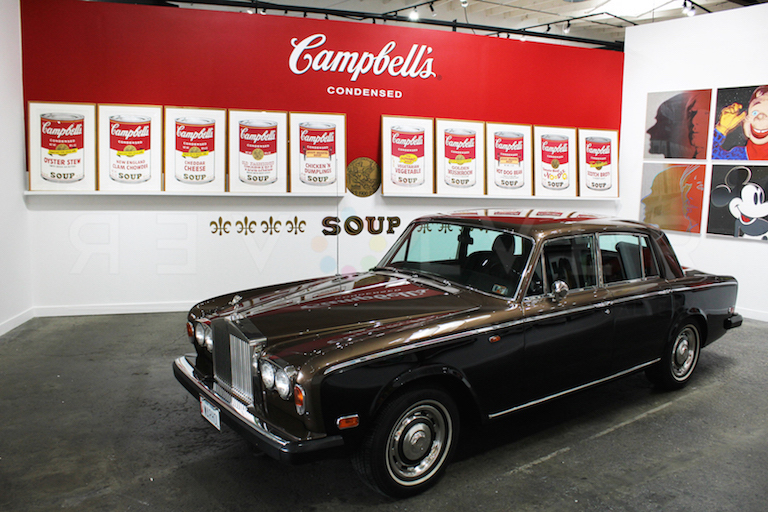Andy Warhol’s 1974 Rolls Royce Silver Shadow is the centerpiece of Revolver Gallery’s “Andy Warhol: Revisited,” which also features Warhol silkscreens of Campbell’s Soup cans, Mick Jagger, Marilyn Monroe and more.
Photos courtesy of Revolver Gallery
Andy Warhol’s work can be controversial, contradictory and misunderstood. But no one can deny its iconic nature. His silkscreens of Campbell’s Soup cans, Marilyn Monroe’s multicolored head and re-fabrications of Brillo boxes not only defined Pop Art, they’ve become synonymous with the visual culture of post-war America.
The significance of these works is well documented in the annals of art history, but one question persists: Why is the art of Andy Warhol still so popular and ubiquitous, even 30 years after his death?
Go into just about any art museum gift shop and you’ll see images that Warhol made famous, reprinted on T-shirts, notebooks, mugs, plates, key chains, postcards and the like. It’s almost Warhol sensory overload, even if that does democratize the act of “owning a Warhol.”
And Warhol wouldn’t want it any other way, says Damon Willick, chair of the Art History Department at Loyola Marymount University.
“I think he would love it,” says Willick, noting that Warhol favored silk screening because it took his personal hand out of the art-making equation. “In fact, he famously said that he hoped his art would inspire people to silkscreen their own Warhols. He also said that he wanted ‘to be a machine.’ He called his studio The Factory. He liked this idea of mass production and commercial production.
“But I don’t think that’s where his popularity comes from,” continues Willick, commenting that the hipness of Warhol’s entourage — an avant-garde gang of gender-benders, actors, amphetamine addicts, hangers-on, socialites and hard-partyers with nicknames like “Viva” and “Ultra Violet” — could be the source of Warhol’s lasting allure.
“The Factory and sort of the crew that hung around Warhol were definitely sort of that New York cool,” says Willick. “They have their Wayfarer sunglasses. They look as if they only come out at night. There’s definitely a coolness to them, and I think that also becomes part of Warhol’s appeal beyond the art, beyond the visual objects.”
But there’s definitely something savory about Warhol’s art products.
“I think people ingest [his art] and digest it and they like it,” says Willick. “It tastes good. It’s very palatable because it’s so familiar. It sort of looks like the advertisements that people are seeing on television and on billboards. … There’s this appeal to that commercialism.”
Michael Dooley, an adjunct professor at LMU and Art Center College of Design as well as a contributing editor to Print magazine, agrees that Warhol’s work is highly consumable.
“Warhol and his art lend themselves to effective branding and easy marketing,” says Dooley, who nonetheless counters that “Warhol’s most well-known work has always been popular with the public for all the wrong reasons.”
Dooley argues that Warhol’s early work in the 1960s — the soup cans and such — was a “critique of consumerism,” but by turning Warhol’s work into purchasable products, we miss the artworks’ original point.
“The message is twisted,” says Dooley. “His ‘Campbell’s’ critiques of consumer culture become safe, flavorless consumables. Their mass-manufacture brings the objects full circle, back onto the shelves.
“Those postcards and other products are drained of their danger and become devoid of all resonance.”
Merchandising, Dooley says, “reinforces the lack of understanding.” A refrigerator magnet of Warhol’s Marilyn Monroe “has nothing to do with the monumental work” that is Warhol’s “Marilyn Diptych,” a silkscreen of 50 Marilyn Monroe images, half in color, half in black and white.
To counteract the “trivialization” of Warhol, Dooley advises people to go see the artist’s work in person. Stand in front of it and take it in. Watch how the colors subtly shift over 50 faces of Marilyn; notice how not every Campbell’s Soup can is exactly the same.
“Stop and see,” he says. “And then see how it makes you feel.”
Ultimately it’s up to the viewer to decide how they feel about Warhol’s work, says Willick.
“People still ask the question, ‘Why is that art? Why is that not an advertisement?’ These are really critical questions for Warhol,” he says, “and I think that intuitively people understand there’s something more going on here, whether they agree with it or not.”


